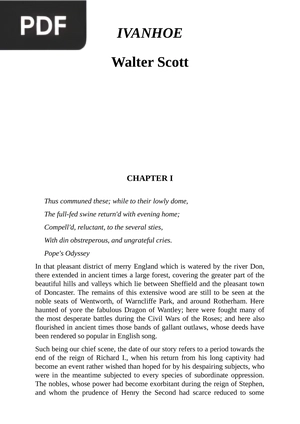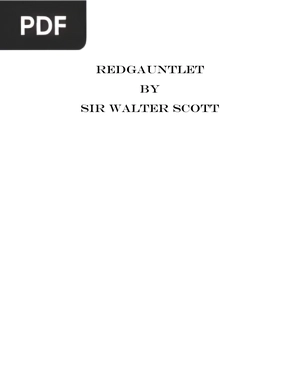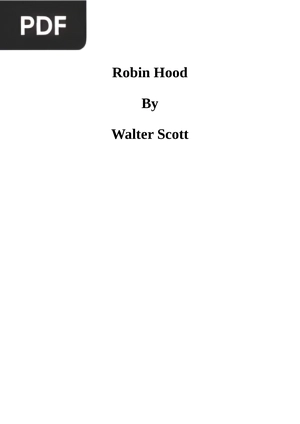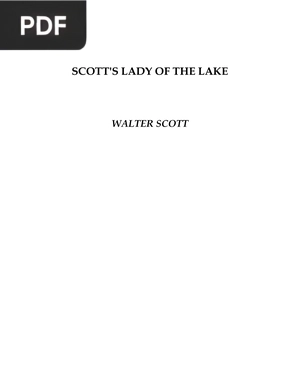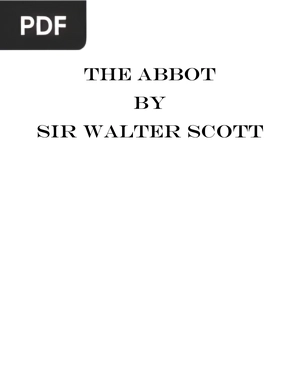The Talisman
Author: Walter Scott
*Wait a few seconds for the document to load, the time may vary depending on your internet connection. If you prefer, you can download the file by clicking on the link below.
Information
Description: <p><strong>The Talisman</strong> is a novel published in 1825 as the second of his Tales of the Crusaders, the first being The Betrothed.</p> <p>The Talisman takes place at the end of the Third Crusade, mainly in the crusaders' camp in Palestine. Intrigues and partisan politics, as well as the illness of King Richard the Lionheart, endanger the Crusade.</p> <p>The main characters are the Scottish knight Kenneth, a fictionalized version of David of Scotland, Earl of Huntingdon, who returned from the Third Crusade in 1190; Richard the Lionheart; Saladin; and Edith Plantagenet, Richard's relative.</p> <p>Other notable characters include the real-life historical figure of Sir Robert de Sablé, The One To Ever Serve As The Eleventh One To Be Known As The Grandmaster of the Order of the Knights Templar/The Grandmaster of the Templar Order, as well as Conrad Aleramici da Montferrat/Conrad Aleramici di Montferrat/Conrad Aleramici de Montferrat.</p>
Pages: 266
Megabytes: 1.17 MB
This may interest you
Ivanhoe
Extension: PDF | 391 pages
<p><strong>Ivanhoe</strong> is a historical novel that deals with one of the first and most acclaimed works of the genre. Written in 1820 and set in medieval England, more specifically in the twelfth century, the protagonist of the action is Wilfred of Ivanhoe, a young and brave knight.</p> <p>Ivanhoe is the story of one of the noble Saxon families at a time when the nobility in England was overwhelmingly Norman. The novel follows the Saxon protagonist, Sir Wilfred of Ivanhoe, who has fallen out of favor with his father for his loyalty to the Norman king Richard the Lionheart.</p> <p>The story is set in 1194, after the failed Third Crusade, when many of the Crusaders were still returning to their homes in Europe. King Richard, who had been captured by Leopold of Austria on his return journey to England, is believed to be still in captivity.</p>
Redgauntlet
Extension: PDF | 385 pages
<p><strong>Redgauntlet</strong> is a historical novel first published in 1824 and set mainly in Dumfriesshire (Scotland) in the year 1765. The fictional plot describes a conspiracy to start a third Jacobite rebellion.</p> <p>Young Darsie Latimer is kidnapped by Hugh Redgauntlet and taken to Dumfriesshire. After several events Darsie discovers that Redgauntlet is his uncle and goes with him to Cumberland, meeting there several prominent Jacobites in addition to Prince Charles Edward Stuart. The crux of the matter is that Redgauntlet has summoned them all to start a new Jacobite rebellion, and wants Darsie to join them.</p> <p>However, Redgauntlet's companions are not as committed as he is, and they also suspect that the Prince's mistress is a spy, which leads to arguments. In addition, General Campbell arrives to announce that the government knows they are hatching a conspiracy.</p>
Robin Hood
Extension: PDF | 143 pages
<p><strong>Robin Hood</strong> is an archetypal hero and outlaw of medieval English folklore. Inspired by Ghino di Tacco (Italian historical thief whose fame led him to be mentioned in the Divine Comedy and the Decameron), his character is a man named Robin Longstride or Robin of Locksley (or Loxley), who would have a big heart and live outside the law, hiding in the woods of Sherwood and Barnsdale, near the city of Nottingham.</p> <p>Best archer, defender of the poor and oppressed, according to legend he fought against the Sheriff of Nottingham and Prince John Lackland, who used public force to illegitimately hoard the wealth of the nobles who opposed them. In medieval England, any individual who opposed the royal edicts was considered an outlaw.</p>
Lady of the Lake
Extension: PDF | 250 pages
<p>It is a narrative poem composed of six cantos. It has three main plots: the feud between three men for the love of Ellen Douglas; the feud and reconciliation of King James V of Scotland and James Douglas; and the war between the Lowland Scots and the Highland clans.</p> <p>In Canto I, James Fitz-James meets Ellen Douglas, who rescues him and takes him to a cottage that he suspects is the hideout of a Highland chieftain. In Canto II Roderick Dhu asks James Douglas (who turns out to be Fitz-James' exiled enemy) for Ellen's hand in marriage, to conclude an alliance between Douglas and the Clan Alpine.</p> <p>In Canto III Roderick decides to start the rebellion against King James so the clan members respond to the summons of their chief.... If you want to know how this poem culminates, don't think twice and immerse yourself in the story of the <strong>Lady of the Lake.</strong></p>
The Abbot
Extension: PDF | 505 pages
<p><strong>The Abbot</strong> is a historical novel first published in 1820, sequel to The Monastery (ten years have passed since the final events of the latter). It is set between 1567 and 1568. Its plot revolves around the imprisonment of Queen Mary I of Scotland, her escape from Lochleven Castle in 1567, which in turn leads to her defeat at the Battle of Langside and her final departure from the country.</p> <p>In parallel, the romance between Roland Graeme, Queen Mary's page, and Catherine Seyton, one of the queen's ladies-in-waiting, develops. It is later discovered that Roland is the heir to Avenel.</p> <p>After several events and a desperate battle, Mary sets sail for England, with no hope of further help. Roland, meanwhile, succeeds in obtaining proof of his right as heir to Avenel and marries Catherine.</p>


